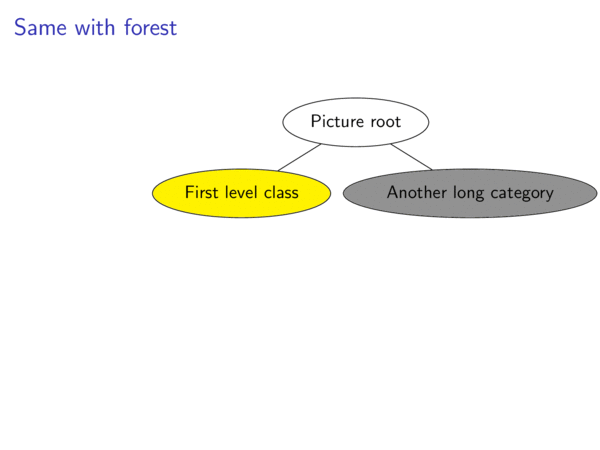I defined a /forest/visible on option that passes its argument to
/tikz/visible on to affect the actual node,- and
/forest/edge (this is the reason we need a visible on option in the /forest tree).
I asume you also want all following children (and their edges) to be invisible that's why we actually use for tree (meaning the subtree).
Other useful options are for children, for descendants, …; see section 3.3.6 Propagators of the forest manual for reference.
In this example we can use the /forest style visible on in a for children option of the parent node of subcategorized and another subcategory. (You may re-define/add various styles so that you can hide
- only the current node (and its edges),
- only the children of the current node (and their edges), and
- the current node and its children (and its and/or their edges).
Code
\documentclass[xcolor={table, dvipsnames}]{beamer}
\usepackage{forest}
\setbeamertemplate{navigation symbols}{} %Remove navigation bar
\tikzset{
invisible/.style={opacity=0,text opacity=0},
visible on/.style={alt=#1{}{invisible}},
alt/.code args={<#1>#2#3}{%
\alt<#1>{\pgfkeysalso{#2}}{\pgfkeysalso{#3}} % \pgfkeysalso doesn't change the path
},
}
\forestset{
visible on/.style={
for tree={
/tikz/visible on={#1},
edge+={/tikz/visible on={#1}}}}}
\begin{document}
\begin{frame}[plain]{Same with forest}
\begin{forest} baseline, for tree={draw,ellipse,align=center}
[Picture root
[First level class,fill=yellow,for children={visible on=<2->}
[subcategorized,fill=gray]
[another subcategory
[last node division,fill=gray]
[in two classes,fill=gray]
]
]
[Another long category,fill=gray]
]
\end{forest}
\end{frame}
\end{document}
Output

You can adapt this answer to How to make beamer overlays with Tikz node:
\tikzset{onslide/.code args={<#1>#2}{%
\only<#1>{\pgfkeysalso{#2}} % \pgfkeysalso doesn't change the path
}}
\tikzset{alt/.code args={<#1>#2#3}{%
\alt<#1>{\pgfkeysalso{#2}}{\pgfkeysalso{#3}} % \pgfkeysalso doesn't change the path
}}
\tikzset{temporal/.code args={<#1>#2#3#4}{%
\temporal<#1>{\pgfkeysalso{#2}}{\pgfkeysalso{#3}}{\pgfkeysalso{#4}} % \pgfkeysalso doesn't change the path
}}
This allows you to put for instance temporal=<overlay specification>{before}{during}{after} in the keyval list anywhere in a TikZ command. onslide works the same way with \only and I included \alt to round out the set.
Here is the complete code:
\documentclass{beamer}
\usepackage{tikz}
\usetikzlibrary{positioning,arrows}
\usepackage{xcolor}
\definecolor{uablue}{RGB}{0,61,100}
\colorlet{uablue100}{uablue}
\colorlet{uablue75} {uablue!75!white}
\colorlet{uablue50} {uablue!50!white}
\colorlet{uablue25} {uablue!25!white}
\colorlet{uablue10} {uablue!10!white}
\colorlet{uablue5} {uablue!5!white}
\definecolor{uared}{RGB}{126,0,47}
\colorlet{uared100}{uared}
\colorlet{uared75} {uared!75!white}
\colorlet{uared50} {uared!50!white}
\colorlet{uared25} {uared!25!white}
\colorlet{uared10} {uared!10!white}
\colorlet{uared5} {uared!5!white}
\tikzset{onslide/.code args={<#1>#2}{%
\only<#1>{\pgfkeysalso{#2}} % \pgfkeysalso doesn't change the path
}}
\tikzset{alt/.code args={<#1>#2#3}{%
\alt<#1>{\pgfkeysalso{#2}}{\pgfkeysalso{#3}} % \pgfkeysalso doesn't change the path
}}
\tikzset{temporal/.code args={<#1>#2#3#4}{%
\temporal<#1>{\pgfkeysalso{#2}}{\pgfkeysalso{#3}}{\pgfkeysalso{#4}} % \pgfkeysalso doesn't change the path
}}
\begin{document}
\begin{frame}<1>[label=overview]
\frametitle{Overview}
\begin{figure}
\centering
\tikzstyle{block} = [rectangle, draw, fill=uablue25,
text width=4em, text centered, rounded corners, minimum height=2em, line width=1pt ]
\tikzstyle{line} = [line width=1pt, -triangle 45]
\tikzstyle{alert} = [text=uared100, fill=uared25, draw=uared100]
\tikzstyle{dim} = [text=uablue25, fill=uablue5, draw=uablue25]
\begin{tikzpicture}[node distance=1.5cm, auto]
% Place nodes
\node [block,onslide=<2->{dim}] (client) {Web Client};
\node [block,onslide=<2->{dim}] (python) [right of=client, node distance=3cm] {Python Service};
\node [block,onslide=<2->{dim}] (wavefront) [right of=python, node distance=3cm] {Wavefront};
\node [block,onslide=<2->{dim}] (AMCL) [above of=wavefront] {AMCL};
\node [block,temporal=<2>{}{alert}{dim}] (VFH) [below of=wavefront] {VFH};
\node [block,onslide=<2->{dim}] (laser) [above right=0.5cm and 1.2cm of AMCL] {Laser};
\node [block,onslide=<2->{dim}] (dash7) [right of=AMCL, node distance=3cm] {DASH7};
\node [block,onslide=<2->{dim},temporal=<3>{}{alert}{dim}] (robot) [right of=wavefront, node distance=3cm] {Robot};
% Draw edges
\draw [line] (client.east) -> (python.west);
\draw [line] (python) -> (client);
\draw [line] (python) -- (wavefront);
\draw [line] (AMCL) -- (wavefront);
\draw [line] (AMCL) edge[out=180,in=90] (python);
\draw [line] (python) edge[out=270,in=180] (VFH);
\draw [line] (wavefront) -- (VFH);
\draw [line] (laser) -> (AMCL);
\draw [line] (dash7) -> (AMCL);
\draw [line] (robot) -> (AMCL);
\draw [line] (VFH) edge[out=0,in=270] (robot);
\end{tikzpicture}
\end{figure}
\end{frame}
\begin{frame}{Introductory stuff}
\begin{itemize}[<+->]
\item Stuff
\item Stuff
\item Stuff
\item Stuff
\end{itemize}
\end{frame}
\againframe<2>{overview}
\begin{frame}{Stuff about VFH}
\begin{itemize}[<+->]
\item Stuff
\item Stuff
\item Stuff
\item Stuff
\item Stuff
\end{itemize}
\end{frame}
\againframe<3>{overview}
\begin{frame}{Stuff about Robot}
\begin{itemize}[<+->]
\item Stuff
\item Stuff
\item Stuff
\end{itemize}
\end{frame}
\end{document}



Best Answer
As Andrew Stacey pointed out
beamerprovides an own\newcommand<>that deals a little better with overlay specification.It is now possible to use
\tikzMe{BCD}<+>.As the overlay-specification argument has the delimiters built-in, so changes need to be made to the
beameralertstyle. I opted for two versions; these styles are equivalent:beameralert=2BeamerAlert=<2>Code
Output
Frame 1
Frame 2
Overlay specifications with
,(e.g.<3,5>)With a small modification overlay specifications with a comma do work:
BeamerAlertcall itself:BeamerAlert={#2}grouping
BeamerAlert'saltcall:Code